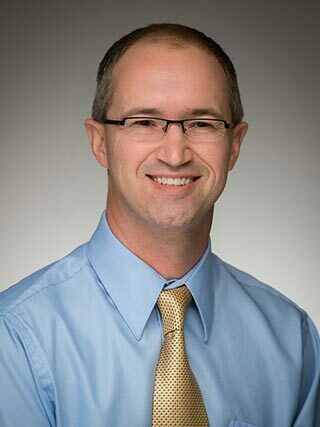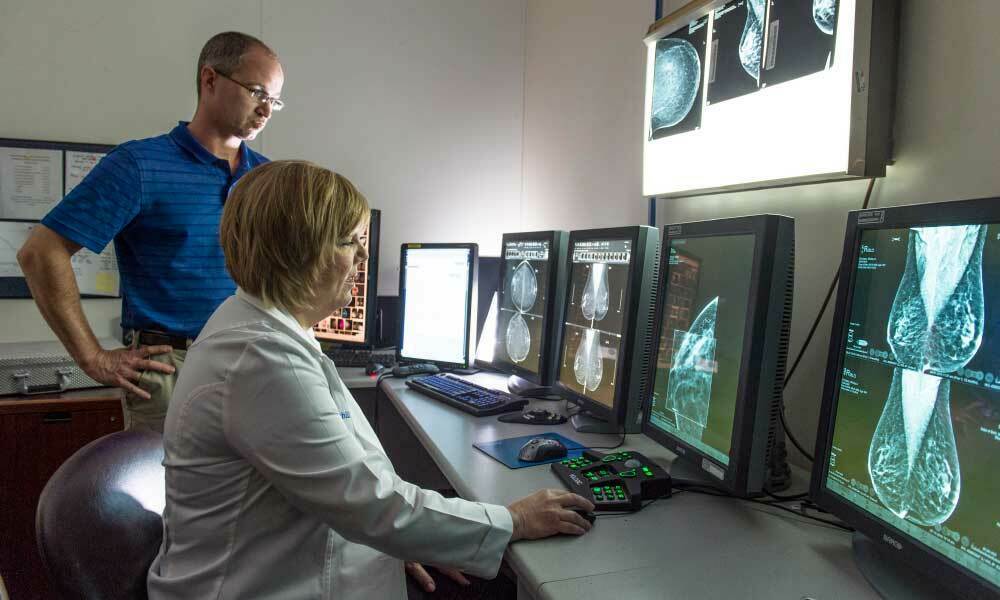Fighting for Better Cancer Detection
It seems black and white: Either you have cancer or you don’t. But for many women the answer is gray. Hazy mammogram gray.

In the United States alone, there are nearly 240,000 breast cancer diagnoses each year, and one in eight women will develop breast cancer at some point in her lifetime. To date, mammograms are the best diagnostic technology for breast cancer. A mammogram’s ability to detect tumors at early stages has made breast cancer one of the most treatable forms of cancer, but there are still almost 50,000 missed diagnoses every year.
For many women, that missed diagnosis comes from having dense breast tissue which prohibits clear results from a basic mammogram. Breasts are made up of three types of tissue: fatty, fibrous and glandular. Most women have a mix of the three, but if the fibrous and glandular tissue outweigh the fatty tissue, women are classified as having dense breasts, wherein lies the problem. Fatty tissue appears transparent on X-rays which makes abnormalities like microcalcifications and tumors easy to see. However, fibrous and glandular tissue are less transparent which makes it difficult to detect abnormalities in a mammogram.
As a double whammy, having dense breast tissue doesn’t only make cancer more difficult to diagnose, it’s also linked to an increased risk of getting breast cancer in the first place.
That’s where Notre Dame engineering professor Ryan K. Roeder comes in. Roeder has devised a way in which gold nanoparticles can be injected into the breast and attach to indicators of cancer, like microcalcifications. Because gold is a heavy metal, in an X-ray or mammogram it will be seen clearly, even in dense tissue.
“The current clinical data suggests that the best hope for controlling breast cancer is early detection by mammography,” Roeder says.
“We could administer, through a needle in the breast, a contrast agent that’s going to help us better determine if this [tissue] is really something we need to be concerned about or not,” he explains. “The contrast agent will allow us to see things that might be masked by dense breast tissue, and will allow us to rule out false positives and negatives.”

The gold nanoparticles are attached to molecules which can target clusters of calcium deposits, or microcalcifications, which are associated with breast cancer. The gold nanoparticles attach if they encounter calcium deposits. Then, when a routine mammogram is performed, those microcalcifications shine brightly, indicating a likely case of breast cancer.
The gold nanoparticles can also be attached to antibodies which target specific receptors on cancer cells, such as HER2, which are overexpressed in certain types of breast cancer. Roeder hopes physicians will be able to target the tumor cells themselves to make more precise diagnoses and monitor tumor growth and metastasis.
One of the reasons this research is so clinically appealing is that it is cost effective. Currently, if a woman has a mammogram with questionable results, she must undergo a biopsy which is costly for hospitals and often traumatic for patients. Roeder explains that because his research focuses on the gold contrast agent instead of a different screening process, hospitals will not need to purchase new technology to get clearer answers. When a question arises, doctors can use existing mammography and X-ray systems to seek out the gold once it’s been injected. Even the gold, he asserts, is used in such small quantities that it would cost less than $20 per injection.

“We’re talking about using the same mammography systems that are already used nationwide for screening and making them better,” he says. His hope is that because this concept uses existing technology — most other options do not — it may stand a chance in clinical trials and eventually be available in hospitals.
What makes Roeder stand apart in the fight against breast cancer, though, is his unique point of view. He isn’t a medical professional — at the outset, he didn’t even know much about breast cancer. But as an engineer he’s looking at the problem of breast cancer from a different angle.


In fact, breast cancer wasn’t his initial target. Roeder designed the gold nanoparticles to target calcium for an entirely different project in orthopedics where it would be used to detect cracks in bone. But when applied, the gold didn’t show brightly against dense bone, even though the calcium targeting was effective. So he thought about where there might be calcium deposits in soft tissue where this technology could be better applied. Breast cancer became the obvious choice.
“This would be incredibly powerful — transformative, I would say — for oncologists and surgeons as they’re diagnosing, planning treatments and following treatments for cancer.”– Ryan Roeder
From there he set out to learn as much as possible about breast cancer. He went to the Harper Cancer Research Institute and met Tracy Vargo-Gogola, an adjunct assistant professor at Notre Dame and a lecturer at IU School of Medicine–South Bend. She taught him about breast cancer, and he introduced his contrast as a possible solution to the problem of inaccurate mammograms. Despite his inexperience in the field, he garnered immediate support.
In time, partnerships with Saint Joseph Regional Medical Center, the Notre Dame Integrated Imaging Facility and the Kelly Cares Foundation followed. For Pacqui Kelly, the desire to catch breast cancer early comes from personal experience. Twice now she’s been diagnosed with the disease, but because she was proactive, she received appropriate treatment and then given a clean bill of health. She realizes, though, that some women aren’t as lucky. Kelly Cares and Roeder’s lab are currently partnering to build a human-scale model of synthetic materials so that Roeder can most effectively simulate what his contrast will do in humans.
 Paqui Kelly, wife of Notre Dame football coach Brian Kelly, is a two-time breast cancer survivor. She leads the Kelly Cares Foundation, which raises awareness for early detection through an emphasis on health, education, and community.
Paqui Kelly, wife of Notre Dame football coach Brian Kelly, is a two-time breast cancer survivor. She leads the Kelly Cares Foundation, which raises awareness for early detection through an emphasis on health, education, and community.
 Paqui Kelly at the Kelly Cares Foundation's annual Pink Out Zumba event held in Notre Dame Stadium. Over 1,000 attendees come out to exercise for breast cancer awareness.
Paqui Kelly at the Kelly Cares Foundation's annual Pink Out Zumba event held in Notre Dame Stadium. Over 1,000 attendees come out to exercise for breast cancer awareness.
Meanwhile, Roeder is also looking at new and advanced imaging technologies, such as spectral computed tomography, that allow color imaging of different contrast agents and tissues. Roeder’s lab is designing and evaluating new imaging probes to leverage the capabilities of this new imaging technology.
“This would be incredibly powerful — transformative, I would say — for oncologists and surgeons as they’re diagnosing, planning treatments and following treatments for cancer,” he says.
Roeder’s project is far from the finish line, but optimism in this fight against breast cancer is high. With luck, partnerships and persistence, the best way to think pink may involve thinking gold.
